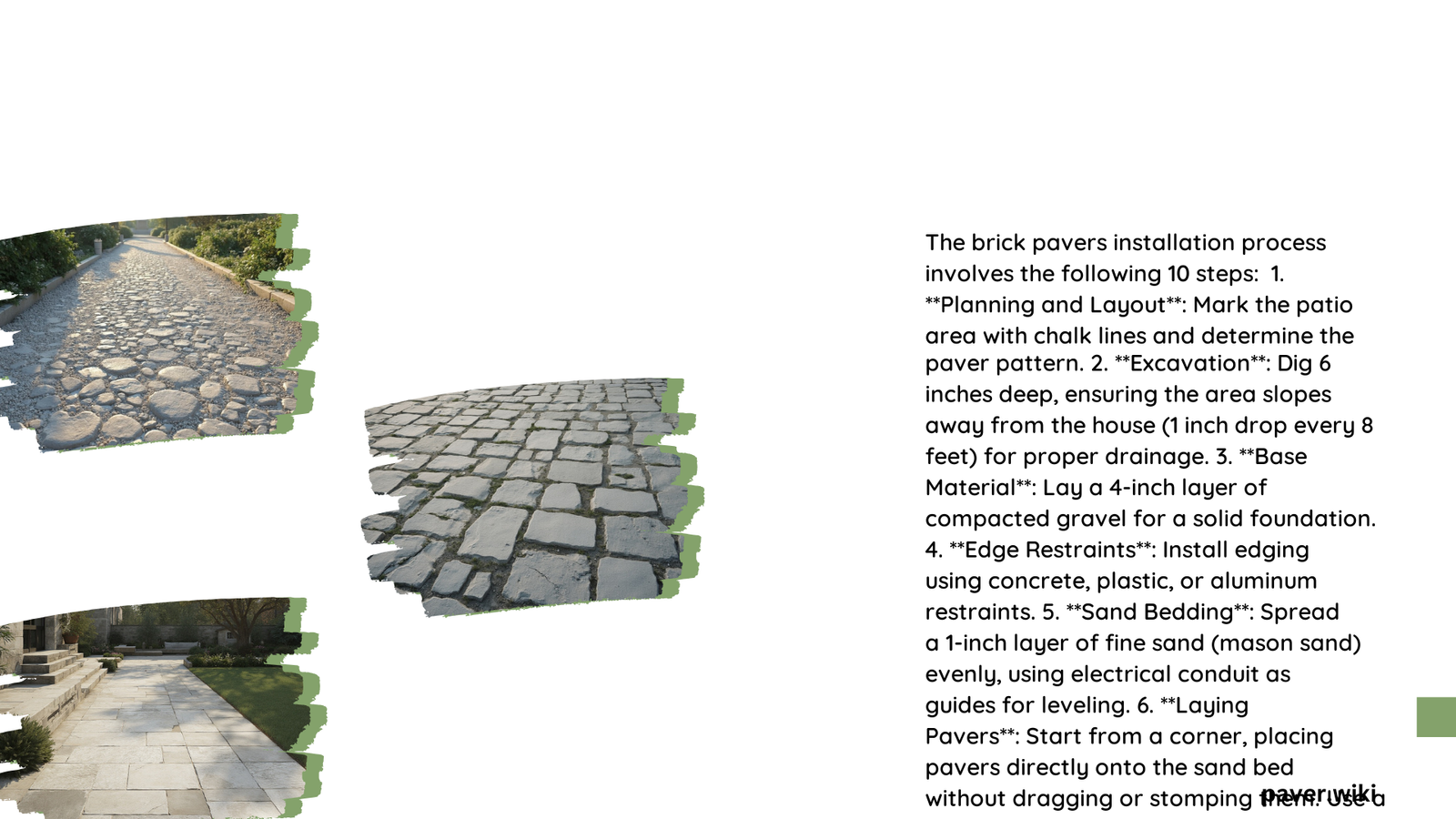The brick pavers installation process involves careful planning, precise execution, and attention to detail. It begins with site preparation and layout, followed by excavation and base material preparation. Next comes the sand bedding, laying of pavers, joint sanding, and edge restraint installation. The process concludes with final compaction and optional sealing. This guide provides a step-by-step approach to ensure a successful brick paver installation.
What Are the Key Steps in the Brick Pavers Installation Process?
- Planning and Layout
- Excavation
- Base Material Preparation
- Sand Bedding
- Laying Pavers
- Sand Joints
- Edge Restraints
- Compacting Pavers
- Sealing (Optional)
How to Plan and Layout for Brick Paver Installation?

Planning and layout are crucial first steps in the brick pavers installation process. Here’s how to approach this phase:
- Measure the area to be paved
- Create a detailed design on graph paper
- Choose a paver pattern (e.g., running bond, herringbone)
- Mark the paving area using stakes and string or spray paint
- Ensure proper drainage slope (typically 1 inch every 4-8 feet away from structures)
What Is Involved in the Excavation Process?
Proper excavation is essential for a stable paver installation. Follow these steps:
- Mark the perimeter with garden stakes and mason’s line
- Calculate the required depth:
- Base material (4-6 inches)
- Sand bedding (1 inch)
- Paver thickness (varies)
- Excavate to the calculated depth, ensuring a slight slope for drainage
- Remove all organic material and debris
How to Prepare the Base Material?
A solid base is crucial for long-lasting paver installation. Here’s how to prepare it:
- Choose the right material: 3/4 minus gravel or crushed rock
- Spread a 4-6 inch layer of base material
- Level the material using a landscape rake
- Compact the base using a plate compactor
- Lightly wet the base to aid in compaction
- Repeat compaction until the base is firm and level
What Is the Process for Sand Bedding?
Sand bedding provides a smooth surface for paver placement. Follow these steps:
- Spread a 1-inch layer of fine sand (mason or paver sand)
- Use electrical conduit or PVC pipes as depth guides
- Level the sand using a 2×4 board across the guides
- Lightly compact the sand with a plate compactor
How to Properly Lay Brick Pavers?
Laying pavers is a critical step in the installation process. Here’s how to do it correctly:
- Start from a corner or straight edge
- Follow your chosen pattern
- Ensure snug spacing between pavers
- Use a rubber mallet to tap pavers into place
- Cut pavers as needed using a masonry saw or mechanical splitter
- Wear safety glasses and gloves when cutting
What Is the Process for Sanding Joints?
Sanding joints helps lock pavers in place. Follow these steps:
- Ensure the paved area is completely dry
- Spread fine-grained sand (paver or polymeric sand) over the pavers
- Sweep the sand into the joints using a push broom
- Use a plate compactor to settle the sand
- For polymeric sand, mist with water to activate the binder
How to Install Edge Restraints?
Edge restraints prevent paver shifting. Here’s how to install them:
- Choose your edge restraint material (concrete, plastic, or aluminum)
- Install the restraints around the perimeter of the paved area
- Secure the restraints according to manufacturer instructions
- Ensure the restraints are level with the paver surface
What Is the Final Compaction Process?
Final compaction ensures a flat, stable surface. Follow these steps:
- Run a plate compactor over the entire paved area
- Make multiple passes in different directions
- Check for any uneven areas and adjust as needed
Should You Seal Brick Pavers?
Sealing is optional but can provide benefits. Consider the following:
Pros of Sealing:
- Enhances color and appearance
- Protects against stains and fading
- Reduces weed growth between pavers
- Helps maintain sand in joints
Cons of Sealing:
- Adds to overall cost
- Requires reapplication every 2-3 years
- Can make pavers slippery when wet
If you choose to seal, follow the manufacturer’s instructions carefully.
What Tools Are Essential for Brick Paver Installation?
For a successful installation, you’ll need the following tools:
| Tool | Purpose |
|---|---|
| Plate Compactor | Compacting base material and pavers |
| Landscape Rake | Spreading and leveling materials |
| Rubber Mallet | Tapping pavers into place |
| Masonry Saw | Cutting pavers |
| Push Broom | Sweeping sand into joints |
| 2×4 Board | Leveling sand bedding |
| Safety Gear | Protecting eyes and hands |
How Much Does Brick Paver Installation Cost?
The cost of brick paver installation can vary widely based on several factors:
- Material costs (pavers, sand, base material)
- Labor costs (if hiring professionals)
- Size of the area to be paved
- Complexity of the design
- Need for additional features (e.g., edge restraints, sealing)
On average, expect to pay between $10 to $30 per square foot for professional installation. DIY installation can significantly reduce costs but requires time and effort.
By following this comprehensive guide, you can successfully navigate the brick pavers installation process, creating a beautiful and durable paved surface for your outdoor space.
References:
1. Oregon State University Extension: 10-Step Guide to Installing Pavers
2. Enhance Companies: Do-It-Yourself Brick Paver Installation Instructions
3. The Home Depot: How to Install Patio Pavers
